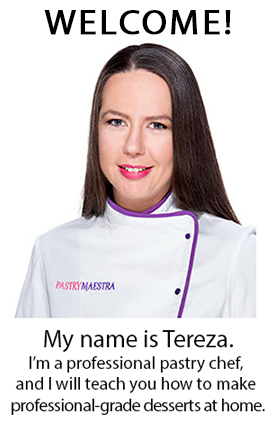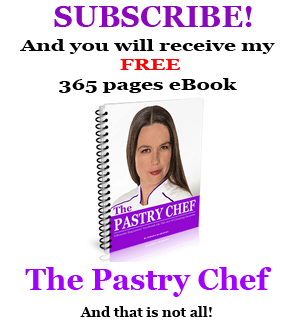
H
ey! You! Yes, You, snap out of it! This is not about Marlon Brando and “The Last Tango in Paris” (although butter is the hero again), this post is about another kind of naughty pleasure and a sweet one indeed! Who doesn’t like buttercream? Whether it is hidden inside of the cake or proudly makes cupcake beautiful, this rich and silky cream has a worldwide reputation. From simple mixture of butter and icing sugar to complicated sugar syrup mixtures, buttercream is luscious in each of its forms. Want to learn how to make one (or four)? Keep reading!
Few Words about Butter…
I’ll be totally honest with you – if, God forbid, butter disappears from this planet, my career and my profession will be over! Simple as that! Butter is the king, always was and always will be! So, let me tell you a thing or two about this miraculous ingredient; butter is really, REALLY old – meaning – thousands and thousands of years old! Naturally, nobody can tell exactly how and when it was invented, but many historians agree that it probably happened by accident. Somebody tied a sheepskin bag of milk to his horse and after a whole day of riding, inside was a faboulous surprise – a lump of butter! What happened? Well, the milk was churning all day, causing the fat and the water to separate and voila- butter was born! Amazingly, this same method is used TODAY – in Syria – a farmer would skin the goat, tie the hide tightly, then fill it with milk and shake! Now – a few words about what we know for sure – for example, in ancient Rome, butter was a cough medicine. In India, Lord Krishna would be offered with tins full of ghee – luscious, clarified butter some 3000 years ago!
Generally speaking, butter was more popular in regions with moderate and cold climate – probably because it melts at room temperature, in fact, butter was so valued – for example in Norway, that the king demanded from his subjects a full bucket every year as a tax! Not only that – and this literally blew my mind – in 15th century, it was forbidden for Christians to eat any animal products – including butter of course, while fasting. Remember – at that time, fasting days were Wednesdays, Fridays, Saturdays and all during Lent, the 40-day period leading up to Easter. Almost half of the year! Now, on the surface it doesn’t look like a big deal, but, this rule, some historians claim, is a foundation of Protestantism!! Can you believe that?! So, what happened – in Rome, where the headquarters of the Church was, people were eating a lot of fish and olive oil, and also – they had no cows, meaning – no butter! So, to them, it was not a problem to obey the church rules! However, in Germany, or France, cow milk and all its by-products like cheese, cream and butter where fundamentals of the diet for local population, and that, historians say, made a monk by the name of Martin Luther really, really angry! But, there was something else – even worse – for well-connected royalty and other wealthy faithful, the church was known to grant reprieves or “dispensations” on the butter ban. In some cases, entire regions were granted permission to eat butter, but only in exchange for an ongoing spiritual “tax”. A special collection box was placed in French parishes to collect butter money, which may have been used to fund the construction of new towers for big cathedrals like those in Rouen and Borges, known to locals as the “Tour de Buerre” or “Butter Tower”.
Isn’t this mind blowing?! However, the worst offense, according to Luther, was that some clergymen were traveling around Germany selling indulgences for the sin of eating butter on fast days to anyone who could pay! Anyway, In Medieval Saxony (now central Germany), Prince Elector Ernst and his brother, Duke Albrecht, decided to change this rule, so – they wrote to the Pope! It took them FIVE popes to have their pleas answered! Finally, in 1490 Pope Innocent VIII sent them a response — known as “The Butter Letter” — which granted the use of butter for their baked goods without having to pay a fine – but only for their household! The Pope was clever and put a condition in the letter stating that others could also use butter for cooking, but whenever butter was used, a donation had to be made! So, like it was mentioned before, a monk named Martin Luther was really, really angry because of this and – the rest is – as they say- history! I don’t know about that, but this whole story is amazing, do you agree – and specially when you know that today we take butter for granted! Now, butter went through some good and some bad times – it was being offered to gods, it was the method of payment, but it was also labeled as an arch-enemy of the cardiovascular system, only to be exonerated lately as healthy and rich in vitamins A and D, good fatty acids and whatnot! Anyway, today, butter is again a good guy, so we have many different varieties of this goodie – regular salted and unsalted butter, grass-fed butter, cultured butter, clarified butter – also known as Ghee, goat and sheep butter etc.etc.
What is Buttercream?
Being so popular, buttercream has many names. Some will say ‘buttercream icing,’ other will use the term ‘buttercream frosting’ but you will find recipes with ‘buttercream filling’ also! Confusing? Not so much! Actually it’s quite simple – buttercream is a multipurpose element of the art of pastry, that can be used inside of a cake as a filling, but also outside for coating, icing or decorating the cake. The most important ingredient is, of course, good quality butter, however; there are bakers out there who use other types of fat like margarine instead of butter. Let’s just say it is a bit odd to use the name buttercream for something that doesn’t contain butter at all, isn’t it? There is an advantage of using margarine – since it has a higher melting point, it is easier to cream it, and it won’t melt at room temperature in warm climates like butter does. If you ask me, I will always prefer butter over margarine, in spite of melting, just sayin’…
4 Types of Buttercream
Although you will find many different recipes and names, there are actually four main types of buttercream:
- Simple or American Buttercream
- French Buttercream
- Italian Meringue Buttercream
- Swiss Meringue Buttercream
I have stumbled upon recipes for “German Buttercream” and “custard buttercream”. That is actually Crème Mousseline – pastry cream enriched with butter, and if that’s what you are looking for, hop to my post about Crème Pâtissière.
Simple or American Buttercream
Simple buttercream is made by creaming together butter and powdered sugar until cream becomes light and aerated. As a rule of thumb, sugar to butter ratio is 2:1, like in my Meringue Kisses recipe. Although its name contains word ‘butter’, this type of buttercream can be made using other fats like margarine, vegetable shortening or lard. Different flavorings and extracts can be added. If a cake is iced with this type of buttercream with high sugar content, and left at room temperature, it can form a thin crust at the surface.
French Buttercream
French-style buttercream, or “Crème au Beurre” [krεm o bɶr] is made by adding softened butter into cooled pâte à bombe – a mixture made of whipped egg yolks and sugar syrup cooked to soft ball stage. For this one you will definitely need a stand mixer! Instead of egg yolks, I’ve seen recipes that call for a mixture of egg yolks and whole eggs, or even only whole eggs to make this buttercream. However, you will have the best result and the creamiest buttercream if using egg yolks only.
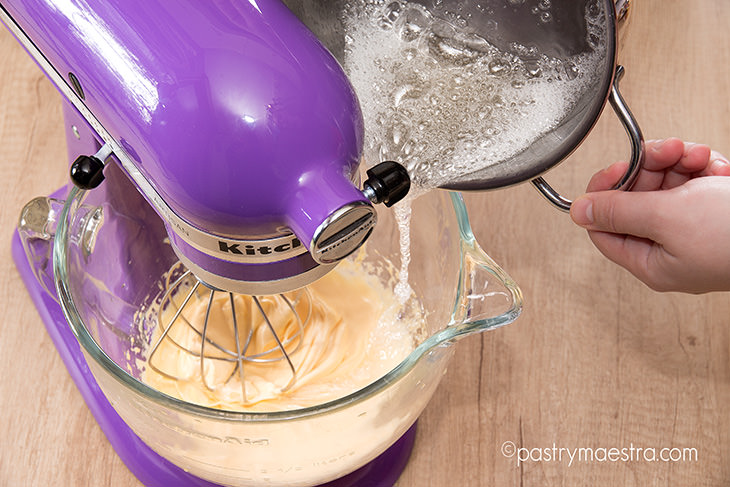
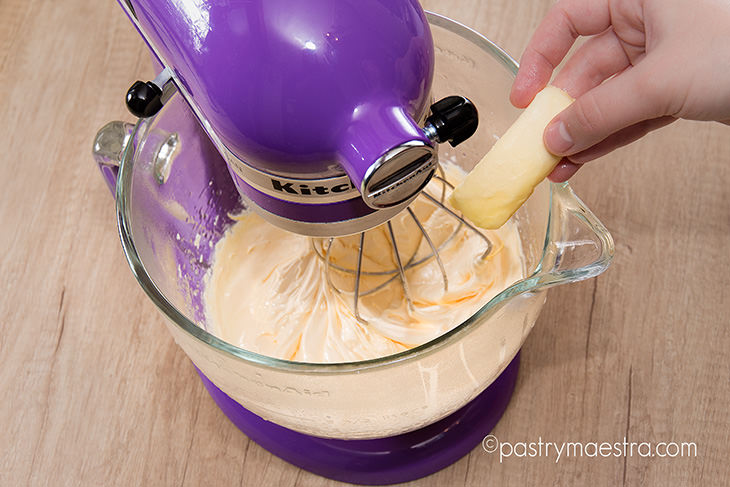
French Buttercream Recipe
by:Tereza Alabanda,The Pastry Maestra
PRINT PDF (EN) ISPIŠI PDF (HR)Prep. time : 20 minutes
Cook time : 5 minutes
Ready in 30 minutes
Level : Advanced
Ingredients:- Egg yolks 150g (5.3oz or 7-8 medium egg yolks)
- Sugar 250g (8.8oz)
- Butter 350g (12.3oz)
- Water, as needed
- Put sugar and water in a saucepan and bring to a boil. Place egg yolks into a bowl of a stand mixer with whisk attachment and start whisking on medium speed.
- When syrup reaches 118ºC (245°F), pour it immediately over whipped egg yolks. Be careful that boiling syrup doesn’t fall on the whisk because it can splatter on your hands or face. Continue whisking until the mixture (pate à bombe) cools at room temperature.
- Gradually add softened butter. When all the butter is mixed in, add flavoring or extract.
Copyright© PastryMaestra.comTM
Italian Meringue Buttercream
This type of buttercream is actually an Italian meringue with softened butter added.
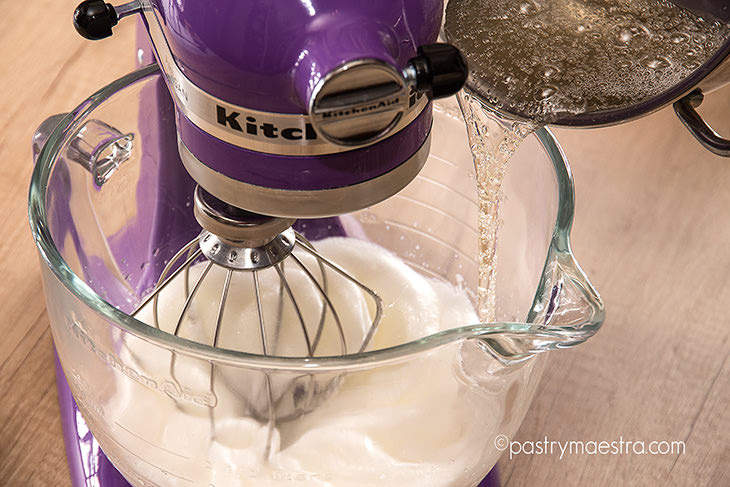
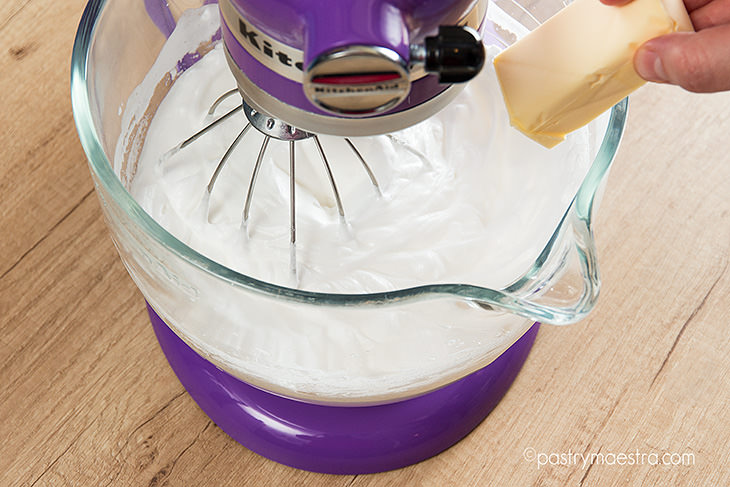
Italian Meringue Buttercream Recipe
by:Tereza Alabanda,The Pastry Maestra
PRINT PDF (EN) ISPIŠI PDF (HR)Prep. time : 20 minutes
Cook time : 5 minutes
Ready in 30 minutes
Level : Advanced
Ingredients:- Egg whites 150g (5.3oz or 5 medium egg whites)
- Sugar 250g (8.8oz)
- Butter 350g (12.3oz)
- Water, as needed
- Put sugar and water into a saucepan and bring to a boil. Place egg whites into a bowl of a stand mixer with a whisk attachment.
- When the syrup boils, continue cooking, and when it reaches 113°C (235°F), start whisking egg whites on medium speed.
- When the syrup reaches soft ball stage 118°C (245°F), pour it immediately over whipped egg whites. Be careful that boiling syrup doesn’t fall on the whisk because it can splatter on your hands or face.. Continue whisking until meringue cools at room temperature.
- Gradually add softened butter. When all the butter is mixed in, add flavoring or extract.
Copyright© PastryMaestra.comTM
Swiss Meringue Buttercream
Swiss meringue buttercream is based on Swiss meringue. Into cooled Swiss meringue softened butter is added.
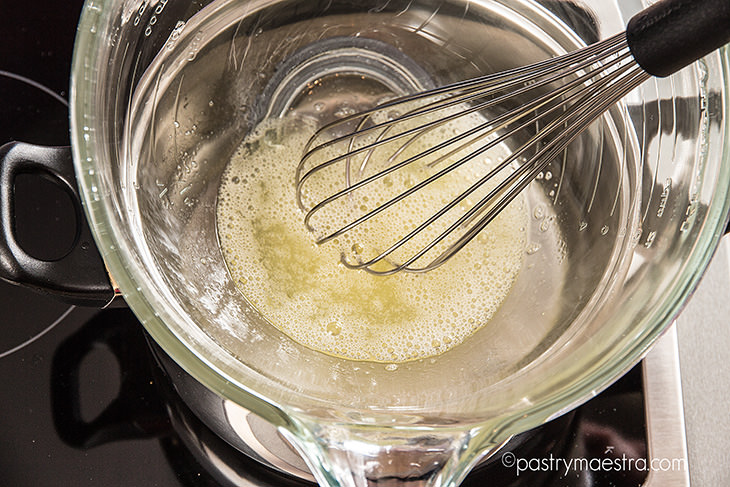
Swiss Meringue Buttercream Recipe
by:Tereza Alabanda,The Pastry Maestra
PRINT PDF (EN) ISPIŠI PDF (HR)Prep. time : 20 minutes
Cook time : 5 minutes
Ready in 30 minutes
Level : Advanced
Ingredients:- Egg whites 150g (5.3oz or 5 medium egg whites)
- Sugar 250g (8.8oz)
- Butter 350g (12.3oz)
- Mix egg whites with sugar into a bowl of a stand mixer. Put the bowl into a bain-marie and stir until the mixture reaches 70°C (158°F) and all the sugar crystals dissolve.
- Remove the bowl from heat and attach it to a stand mixer. Whisk until the meringue cools and becomes stiff.
- At this point gradually add butter and continue beating until butter incorporates into the cream. Add extract or flavoring as wish.
Copyright© PastryMaestra.comTM
10 Best Buttercream Flavors and How to Make Them
If you are not overly ecstatic about loads of butter mixed with sugar, you will probably be happy to hear that you can flavor your buttercream in various ways:
- Add melted chocolate to buttercream. Make sure that it isn’t too warm, it could melt the butter.
- Add vanilla powder to buttercream, it will make it wonderfully fragrant and delicious.
- Hazelnut or pistachio paste will give special aroma to your buttercream. Add to taste.
- Reduced raspberry puree – cooled, of course – will make wonders to your buttercream!
- Use any other reduced fruit puree or jam to flavor your buttercream.
- Make the lemon or passion fruit curd, cool it down and add it to buttercream. Yummy!
- Enrich your buttercream with softened cream cheese.
- Add coffee extract to your buttercream, it works great with chocolate cake!
- Make your unique buttercream flavor – add a few drops of natural rose or violet extract.
- Put a few drops of mint or bergamot essential oil and make your buttercream extra special and flavorful!
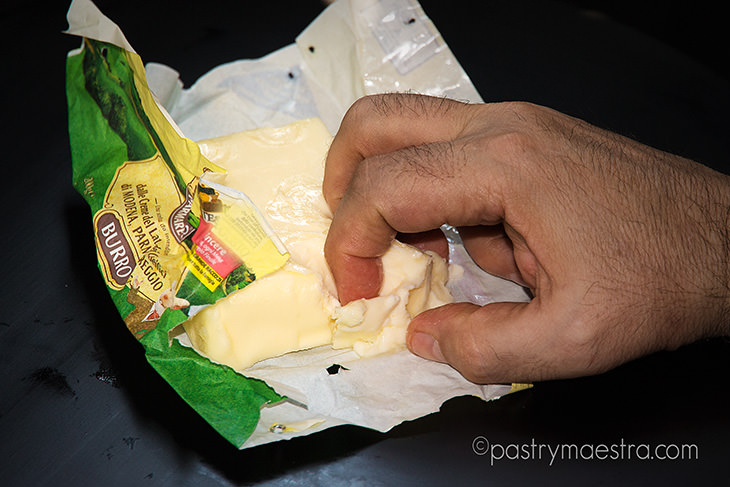
Well, it’s time to take a deep breath and dive, head on, into buttercream foursome! Experiment, explore, enjoy! And, of course – let me know how it went! Juicy details n’all!
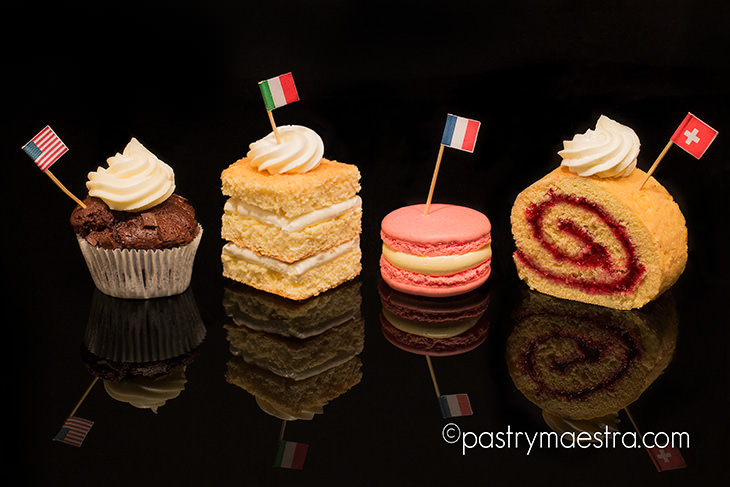
Well, what do you think about this post?
Please leave your comment on YouTube, thank you!
I read and really appreciate all the comments, even though I do not always have the time to respond to each one. So – keep me in the loop and try to create some sweetness every day because – Sweetness is happiness!!



